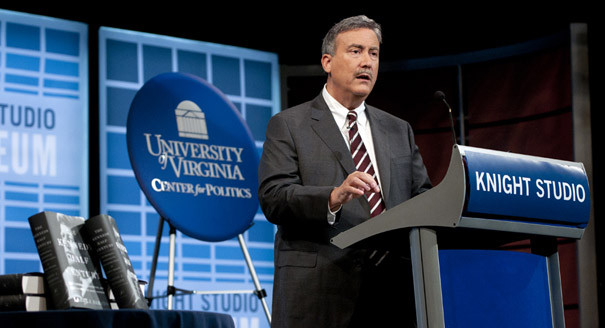JFK book assails conspiracy theory

The book questions the House assassinations committee’s finding. | John Shinkle/POLITICO
A forthcoming book raises serious doubts about a key piece of evidence that led a House committee to conclude in 1979 that President John F. Kennedy was likely killed as part of a conspiracy.
University of Virginia political scientist Larry Sabato commissioned a scientific analysis of the Dallas Police Department’s Dictabelt recording of scanner traffic from Nov. 22, 1963, as part of his research for “The Kennedy Half Century: The Presidency, Assassination, and Lasting Legacy of John F. Kennedy.”
Advertisement
Investigators for the House Select Committee on Assassinations relied heavily on the tape to say there was a high probability that Lee Harvey Oswald was not the lone gunman. The microphone on a motorcycle cop’s radio was stuck, so it was believed to capture a full recording from the motorcade. They detected four gunshots on the tape, and two academics told the committee that they believed one came from the grassy knoll — not the Texas School Book Depository.
( PHOTOS: Who’s who in the Kennedy family)
Dealey Plaza was even closed on a Sunday in August 1978 so sharpshooters could fire into sandbags, and the noises were recorded. Acoustics experts crosschecked those recordings against the 1963 tape.
Sabato will unveil his findings Tuesday, during a press conference at the Newseum in Washington, to coincide with the publication of a 624-page tome he has been working on for five years. He offered a sneak preview to POLITICO.
“The long-hoped-for Rosetta Stone of the Kennedy assassination is nothing of the sort,” he writes. “And the much-publicized conclusion of proven conspiracy … was deeply flawed and demonstrably wrong.”
It turns out that the motorcycle cop whose radio was transmitting was not where the investigators believed him to be when they did their tests. He was actually more than two miles away in a place where his radio could not have picked up the sound of gunshots.
The firm Sonalysts concluded that some of the sound impressions on the recordings that were interpreted as gunfire a generation ago are nearly identical to other sound impressions earlier on the tape that are definitively not gun shots.
“In fact, there are no less than twelve similar impulses in a period spanning just over a three-minute segment of the open microphone audio,” Sabato writes, guessing that they are probably “of a mechanical origin associated with the motorcycle.”
Others have previously questioned the House assassinations committee’s finding. A 1982 National Academy of Sciences panel called its report “seriously flawed” and said there “was no acoustic basis” for claiming a shooter on the grassy knoll.
Sabato ridicules the House committee’s methodology and says it relied too much on estimates. The frequent political commentator, who has written two dozen books, also strongly criticizes the Central Intelligence Agency for continuing to hold back documents about the assassination. Many potentially important government documents are not scheduled to be released until 2017.
“No one has offered a convincing explanation for the CIA’s special treatment of Oswald’s paperwork in the weeks leading up to the assassination,” wrote Sabato. “It is beyond question that the CIA lied to the Warren Commission in 1964 and then again to the House Select Committee on Assassinations in the late 1970s.”
The author, who founded and directs the Center for Politics at University of Virginia, also contracted with Hart Research to conduct a national survey about the public’s view of Kennedy, specifically his enduring crossover appeal, detailed in another section of the book.
Sabato also interviewed several key political figures, from former President Jimmy Carter to House Democratic Leader Nancy Pelosi, about how Kennedy’s legacy has affected them. The book includes detailed chapters about how the flame of Camelot shaped every subsequent president, from Lyndon Johnson to Bill Clinton.
Sabato concludes that “a conspiracy of some sort … cannot be dismissed out of hand.” But he said there is no doubt that Oswald was “at least one of” Kennedy’s assassins. Just because the tape could not prove a conspiracy, he explains, does not mean there was not someone on the grassy knoll.
Ultimately, Sabato believes we will never know with certainty what really happened 50 years ago. Scholars, he said, will probably still be debating it a century from now.
“The search for the truth of JFK’s assassination is like the quest for El Dorado, the mythical city of gold that tantalized European explorers in the 16th century,” he writes. “Inspired by vague clues and Amerindian legends, these explorers spent years in the wilderness hoping to strike it rich, but often died of disease and starvation instead.”
*** This article has been archived for your research. The original version from POLITICO can be found here ***


